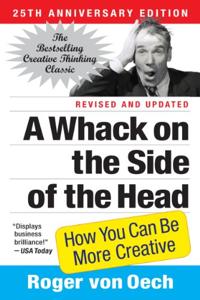
Want to learn the ideas in A Whack On the Side of the Head better than ever? Read the world’s #1 book summary of A Whack On the Side of the Head by Roger von Oech here.
Read a brief 1-Page Summary or watch video summaries curated by our expert team. Note: this book guide is not affiliated with or endorsed by the publisher or author, and we always encourage you to purchase and read the full book.
Video Summaries of A Whack On the Side of the Head
We’ve scoured the Internet for the very best videos on A Whack On the Side of the Head, from high-quality videos summaries to interviews or commentary by Roger von Oech.
1-Page Summary of A Whack On the Side of the Head
Ten Mental Locks
In order to be creative, you must have an attitude that lets you search for ideas and play with your experience and knowledge. You can find practical solutions by breaking the rules sometimes. People are not taught to be creative, because they’re expected to follow the same steps as other people in their educational system. These attitudes prevent them from finding new ways of doing things when they need to think creatively. Many people who don’t let themselves be creative often have attitudes that lock them into thinking with the status quo; these include “mental locks”, which are hazardous to your creativity if left unchecked.
Awareness and openness can unlock the secrets of creativity. These are important concepts that you need to remember when generating ideas. Sometimes, a simple change or unusual situation can revitalize your thinking process and open up new doors for exploration which may not have been obvious before.
Mental Lock #1: “The Right Answer”
The average person has taken over 2,600 tests and exams by the time they finish college. This reinforces the thought process that there is one right answer; however, in life there are many right answers. If you believe that there is only one right answer, you will stop looking as soon as you find it.
Since there’s no single right answer, you should look for a second one. It might be strange or unusual, but it’ll probably work out better than the first idea. Just like professional photographers take hundreds of pictures to get exactly what they want, you should generate as many ideas as possible before deciding on any one course of action.
Mental Lock #2: “That’s Not Logical”
There are two types of thinking, hard and soft. Hard thinking is logical and exact whereas soft thinking is metaphorical and humorous. Soft thinkers are more creative than hard thinkers because they’re able to consider more possibilities. However, during the implementation phase of a project, hard thinking is necessary because it’s very clear-cut and practical. It can be difficult for people who think with a softer approach to execute their ideas without some help from those who have a harder approach to things.
Logic can be helpful, but it’s not always needed. If we rely on logic too much, we might miss out on the softest and most valuable creation of our mind: intuition. We should pay attention to our intuition rather than trying to figure everything out logically.
Mental Lock #3: “Follow the Rules”
Creative thinking is both constructive and destructive. You will often have to break out of an old pattern before you can create a new one. Play the revolutionary; challenge the rules. People feel pressured to follow the rules, but that’s not always good for creativity. If no one dared to break them, there would still be a jump ball after every field goal in basketball, foul balls wouldn’t be called as strikes in baseball, and there would be no passing game in American football. The danger in never challenging the rules is that you can become too focused on one approach or strategy when others might work better. Don’t be afraid to kill a sacred cow!
Mental Lock #4: “Be Practical”
Ask yourself some “what if” questions to get your creative juices flowing. What if you were someone else? How would Churchill, Beethoven or a seven-year-old girl approach this problem? You can also use stepping stones to help lead your thinking in different directions. A chemical engineer once wondered what would happen if gunpowder was added to house paint. He explained that he had noticed how chipping and cracking paint could be removed by blasting it with a shotgun, so he wanted to find an easier way of doing it. Sometimes impractical ideas will lead to practical ones, like the company selling the new type of paint years later because someone asked what would happen if something else was put into the paint instead of gunpowder.





